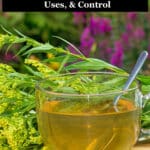Goldenrod – Growing, Foraging, Uses, & Control

Our land has an abundance of goldenrod plants, which provide a blast of fall color and food for pollinators. They’re also useful for food, medicine, and more. We’ll share tips for identifying the plants in the wild, growing them in the garden, and how to use them.
There are over 100 species of goldenrod in the genus Solidago. Our yard has Solidago canadensis, Canada goldenrod. Canada goldenrod is also known as common goldenrod, tall goldenrod or Aaron’s rod. It tolerates dry conditions and poor soil.
Native to North America, these plants may be considered invasive on other continents due to their vigorous growth habit. They spread through rhizomes, forming dense clumps that can create a monoculture. As a perennial, it returns year after year.
Plants in the Solidago genus have alternate lance shaped leaves and golden yellow flowers. Goldenrod blooms in summer and fall, with composite flowers. The individual flower heads form spiked flower clusters (except in varieties like flat topped goldenrod, which has a more open form).
For best flowering, plant Solidago species in full sun. These plants tolerate and even thrive in poor soil, so avoid excess fertilizers. Too much fertilizer can cause tall, floppy growth. It’s fine to pinch back growing tops to encourage sturdy growth, and dead heading will prolong flowering.
To keep the plants from spreading, you may want to plant them in a large, sunken pot (like mint). Another option is to plant them where you can mow around them to keep them in check.
A third option is to choose smaller cultivars, like “Golden Fleece”, which matures at only 15 to 18 inches tall. (Wild species range between one and six feet tall, depending on the variety and conditions.) Remove spent flowers in fall to prevent self-seeding.
The plants sometimes get powdery mildew and leaf spot. Don’t overwater, and try to maintain good air circulation.
Goldenrods can make good companion plants for vegetable gardening. They attract beneficial insects, such as soldier beetles and crab spiders, that eat garden pests. They also provide an abundant nectar source for bees and butterflies.
Although it is commonly blamed for hayfever and allergies, only 1-2% of autumn airborne pollen is from goldenrod. Ragweed is generally the real culprit.
Ragweed pollen is small and light, and readily becomes airborne. Solidago pollen is larger and sticky. People who react to Solidago species pollen generally have to be close to the plants to trigger a reaction.
Some people may have a mild skin reaction (contact dermatitis) when exposed to goldenrod. I have not. I do react from contact with ragweed.
Goldenrod is edible from root to flower. Harvest roots in early spring. Clean, dehydrate, and grind into flour, or chop finely and use in soups and stews.
Use leaves as a potherb or in herbal tea. Flowers can be eaten raw or cooked. This simple goldenrod sauce is good with fish. The bright flowers compliment the lemon and butter.
Goldenrod Sauce
Melt the butter in a skillet, add the flowers, and simmer lightly for ten minutes. Add the lemon juice and blend; season with salt and pepper.
Goldenrod has a long history of medicinal use. It is astringent, diuretic, anti-microbial, anti-inflammatory, and antispasmodic. It’s used topically for wounds, burns, boils, stings, and strains. Internally, conditions treated include:
Do not use if pregnant, and always check with your healthcare provider if you are on prescription medications.
To make a simple goldenrod tea:
Gather leaves and flower buds, roughly 2-3 tablespoons per cup. Rinse of the leaves and buds and place them in a mug. Pour a cup of boiling water over the plant material and infuse for 10 minutes.
Strain and add honey to taste, if desired. The tea has an anise-like flavor. If using dried plant material, use 2-3 teaspoons per cup.
Canada goldenrod can also be used to dye fabrics. The article “Dyeing with Goldenrod” shares the colors created using the techniques described in the book, “A Dyer’s Manual“. The range of colors shown in the photos is very interesting.
The stems of Solidago plants are often invaded by insect larvae, causing bumps or galls in the stem. You can harvest these bumpy stems for free fishing bait. The video below explains how to identify and harvest the larvae. These replace the meal worms typically sold for ice fishing.
This article is part of the Weekly Weeder series, which shares how to use wild plants for food and medicine.
Other articles in the series include:
New England Aster – A Great Fall Nectar Source for Bees
Jewelweed – Traditional Remedy for Skin Ailments
Thanks for taking the time to visit, and I hope you’ll be back again soon. As always, if you’ve enjoyed the post, please pass it along. Let me know if you try out any of the uses, too.
This article is written by Laurie Neverman. Laurie was raised on a small dairy farm in northwest Wisconsin, where she gathered wildflowers from the woods and pastures. Now she and her family have 35 acres in northeast Wisconsin, where they mix intentional plantings and semi-wild areas. Every season is a new opportunity to learn more about working with wild plants.
Originally posted in 2011, last updated in 2023.
It makes a HUGE difference when you share our articles. Thank you so much!
